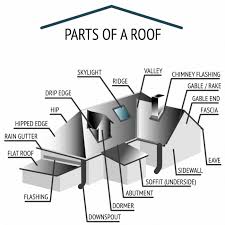Our homes are protected from all types of weather by well-built residential roofs. All kinds of structures benefit from their addition to their aesthetic appeal and architectural personality. A roof has its own anatomy, identity, and main functional components, keeping in mind both practicality and elegance, just like any other structure. It’s critical to comprehend what those components consist of. For your benefit, we’ll go over the anatomy of a roof in this article. Please keep reading.
Truss
Trusses serve as the roof’s skeleton. It determines the roof’s slope and frequently determines what kinds of roofing materials you can use. The truss includes rafters. These wood lengths are secured with nails for the decking material.
Decking
The flat surface to which the rest of the roofing system is attached is referred to as decking, also known as wood sheathing. The rafters are covered with plywood, OSB, or other materials that look similar. The old roofing is removed to reveal the decking during a roof replacement.
Ice And Water Shield
An ice and water shield is a waterproof membrane used to protect your roof from ice and water damage. In the event that water leaks through your roofing material (metal roof, asphalt shingles, etc.), it safeguards your roof decking.).
The following areas of your roof should have ice and water shield installed: roof valleys, around penetrations, and on roofs with a 2/12, 3/12, or 4/12 pitch. It is essential and should be present on every roof.
Roof Underlayment
Roof underlayment is a felt (15 lb, 30 lb, or synthetic) roofing material that lays between your roof decking and your shingles. It adds an extra barrier of defense against the elements and is installed directly over your roof decking.
If water penetrates beneath your shingles, underlayment is the final line of defense for the decking of your roof. You should make the best underlayment investment you can because of how crucial it is.
Starter Shingles
Starter shingles are a pre-cut row of roofing material that goes underneath the first course of shingles before they’re installed.
On the edges of your roof, it ensures that there is protective material between the joints where the shingles rub against one another.
To make sure the first row of shingles is sealed at the edges of your roof, starter shingles also have an adhesive. Strong wind resistance is increased by this adhesive seal on your roof.
Roof Coverings
The final layers used on a roof, which can differ from actual roof coverings, are used. The underlayment and sheathing are covered, and this is what gives a roof its distinctive appearance.
Although other materials like shakes, tiles, slate, stone, metal or synthetic materials are also options that can be used in modern homes, asphalt shingles are still thought of as standard fare for moderately priced housing.

In addition, foam, single-ply roofing, built-up roofing, and modified bitumen are roofing materials used for commercial buildings.
Fastener Attachments
Any roofing materials are attached to the underlayment and deck using fasteners. Roofing nails for asphalt shingles, metal fasteners for tiles, and even bonding, glue, tar, or adhesive type paper can be used to secure some types of roofing materials to a roof.
Flashing
Flashing is typically sheet metal or another robust material that is used to cover and protect specific protrusions of a roof. Flashing is used around joints and angles on a roof as well as chimneys, vents, and other potential water leak locations. Flashing facilitates the movement of water down any gutters or downspouts and helps direct water away from the interior of a roof.
Vents
A roof needs vents to breathe properly. They remove any moisture-producing buildup from a roof that could otherwise result in mold, mildew, rot, or other unwanted accumulations.
Gutters And Drip Edges
The removal of water from a roof and its direction away from a building’s foundation are both accomplished by gutters and drip edges, which are crucial components of any proper roof design.
Attic Space
Under the roof is where you’ll find an attic. For the protection of a roofing system, this area needs sufficient ventilation. Ventilation prevents heat buildup in the summer and assists in controlling warm, humid air in the winter. To maintain a home at a reasonable and comfortable temperature throughout the year, proper ventilation is required.
Reasons You Need To Invest In Quality Roofing Materials
You now understand how a roof is built and what you need to know about each material. To keep you and your family dry, every component of your roof serves a specific purpose.
However, if your roofing materials and components break, you can’t rely on them. Consequently, it’s imperative to spend money on quality rather than attempting to find more affordable alternatives.
However, this is only one of the reasons you should spend money on high-quality materials. We wrote another article outlining the three ways a cheap roof will end up costing you more, in the long run, to help you avoid wasting your hard-earned cash.
Too many Nashville homeowners have had their roof investment ruined by shoddy labor and supplies since 1990, according to the team at Bill Ragan Roofing. Because of this, we work to inform homeowners like you so they can make the most of their roof replacement.





